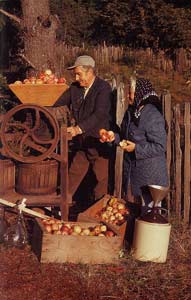The Makings of a Good Cider

For at least 2,000 years, humans have been making apple cider wherever they could grow the fruit. In America between 1650 and 1850, almost every Yankee farmer had a basement full of cider barrels, and hard cider was on the table for each meal. By the mid-19th century, however, cider was being supplanted by beer, and cider making was eventually singled out for suppression by the temperance movement. In most apple-growing regions of the world today, the term cider means a beverage made from the juice of milled apples that has been collected in large barrels and fermented with yeast, like grape wines. Only in North America is fresh or sweet cider a popular drink. Elsewhere, fresh cider is either processed into apple juice, fermented to make hard cider, or fermented and then distilled and blended to make apple brandy, applejack, or eau-de-vie.
Apple juice averages about 13 percent sugar, which produces a naturally fermented cider with around 6 percent alcohol by volume. Fermentation begins within a few days in a barrel of cider at cellar temperatures, around 55°F, and is completed in several months. Fermentation in an environment that is somewhat cooler than typical room temperature often improves the flavor of cider. If it is kept in an airtight container with a suitable "airlock" that permits carbon dioxide (produced by yeast as it converts sugar into ethanol) to escape but prevents oxygen from entering, hard cider will keep for a year or more; after that its flavor does not improve much. In the presence of oxygen, bacteria will eventually convert hard cider into a vinegar that has many culinary purposes.
Pasteurized or Not?
Until recently, the fresh cider sold in the United States was the unadulterated, unpasteurized juice of fresh-pressed apples. Cider that includes a blend of sweet and tart varieties usually has an acidity level, or pH, of around 3.6—enough acid to suppress most pathogenic bacteria. But recently a dangerous new form of the common bacterium Escherichia coli has developed that can survive even very acidic conditions. Almost all commercially produced cider is now heat-treated to temperatures around 170°F for several seconds in a flash-pasteurization process similar to milk sanitation. If done correctly, this has little effect on the flavor, suppresses potential pathogens, and greatly increases cider's shelf life in the refrigerator.
Cider makers who use only unblemished apples that have never touched the ground, follow a rigorous series of sanitation procedures to cleanse every apple, and routinely test their cider for E. coli are still permitted to sell their cider as unpasteurized, with a printed warning that explains potential health risks to consumers. Pasteurization is not necessary for hard cider because the ethanol produced during fermentation is a natural preservative that eliminates potential pathogens.
In most states it is legal to produce small quantities (up to a few hundred gallons annually) of beer, wine, or hard cider for personal consumption, and the basic equipment for home fermentation is readily available at beer or wine-making supply stores.
The best ciders are made from a blend of many varieties: some with lots of acidity, others high in sugar, and some that impart desirable flavors and aromatic qualities to the cider. Tart apples such as 'Baldwin', 'Calville Blanc', 'Empire', 'Esopus Spitzenberg', 'Golden Russet', 'GoldRush', 'Idared', 'Liberty', 'McIntosh', 'Mutsu', 'Newtown Pippin', 'Northern Spy', 'Roxbury Russet', and 'Winesap' are excellent sharps for cider blends. Apples that are typically high in sugar, such as 'Golden Delicious', 'Fuji', 'Gala', 'Golden Russet', 'GoldRush', 'Jonagold', 'Red Delicious', and many others are wonderful sweets. Apple varieties with astringent tannins impart flavors other than sweet and tart, adding complexity, a long finish, and a rich "mouthfeel" to sweet or hard ciders. These apples are known in Europe as bittersweets if they are high in tannins and sugars, or bittertarts if they have both acidity and tannins. A few of the dessert and culinary apples included in the encyclopedia—'Golden Russet', 'Northern Spy', and 'Liberty'—add significant amounts of tannins and other unique flavors to cider blends. Some crabapples grown as ornamental trees produce fruit high in tannins and acidity and can be blended with sweet and tart apples to make a good hard cider.
High-quality European-style fermented ciders include about 20 percent of bittersweet varieties such as 'Tremletts Bitter', 'Hereford Redstreak' and 'Somerset Redstreak', 'Dabinett', 'Chisel Jersey', 'Kingston Black', 'Ellis Bitter', 'Binet Rouge', or 'Medaille D'Or'. Trees of these varieties are available from several nurseries specializing in antique apples. They can be grown successfully in Zones 5 to 7 but do best in cooler regions with long, mild summers. These will provide plenty of tannins in a cider blend.


